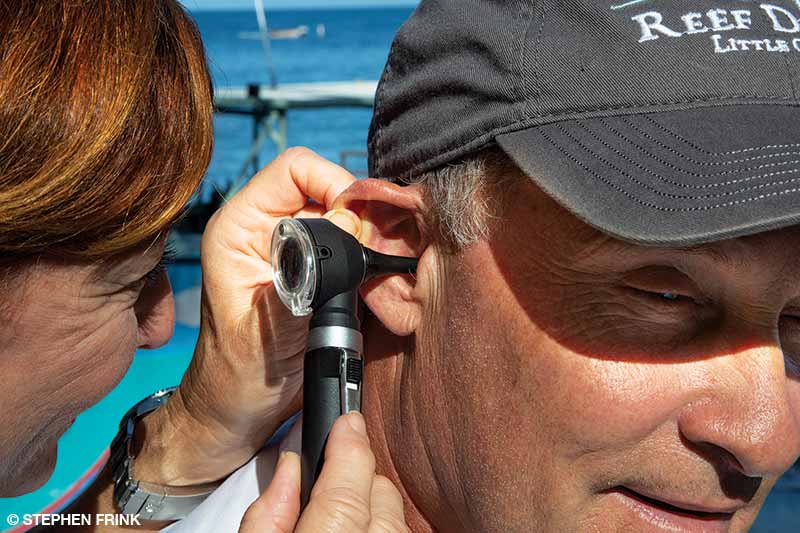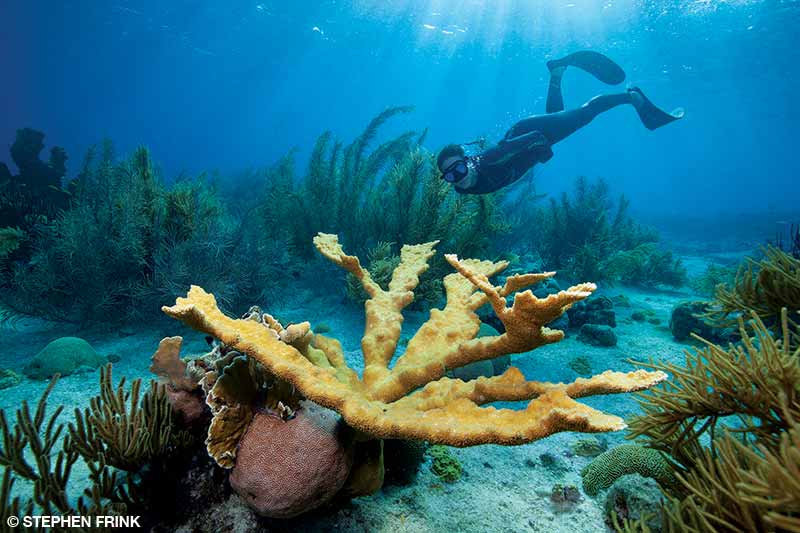DAN® medical information specialists and researchers answer your dive medicine questions.
I was diagnosed with chronic obstructive pulmonary disease (COPD) last summer. I get short of breath when I exercise, but I still swim for about an hour three times a week, including a 75-foot (23-meter) underwater swim with fins. How will COPD affect my diving?
Unfortunately, COPD is a contraindication to diving for several reasons. With COPD, there are abnormal enlargements of the air spaces in the lungs and destruction of the air sac (alveoli) walls, reducing their elasticity. The alveolar walls are normally elastic like a balloon. A balloon expands when you breathe into it, but the walls are ready to recoil and expel the air, which is how normal alveoli function. With reduced elasticity, it is more like breathing into a plastic bag. It expands, but the walls do not actively force out the air. Any air remaining in the alveoli creates a much higher potential for pulmonary barotrauma.
The volume of gas is inversely proportional to its absolute pressure, which your open-water instructor probably demonstrated to you using a balloon. The balloon filled with air at depth expands during ascension, which teaches the importance of never holding your breath while diving. If your lungs cannot quickly expel all the air, it creates a situation similar to partially holding your breath while diving since the trapped air will expand, possibly to the point of rupturing your lungs. A rupture leads to air escaping the lungs and potentially entering arterial circulation, which can cause an arterial gas embolism (AGE), or the chest, resulting in a life-threatening pneumothorax. The bubbles that cause an AGE may lodge in the lungs, heart or brain and result in a pulmonary embolism, heart attack or stroke, respectively.
Some people with COPD retain carbon dioxide (CO2), which creates a risk of CO2 toxicity at depth. Reduced exercise tolerance is also common for those with COPD and poses risks for diving. There can be strenuous activity involved with managing currents, swimming on the surface in choppy seas or pulling yourself and your wet, heavy gear up a ladder and onto an unsteady boat. You may also have to walk in full gear along a boat deck after an exhausting dive.
With COPD, shortness of breath during exertion doesn’t mean you are out of shape; it means you cannot rid your body of CO2 and replace it with the oxygen needed to meet the demand of your exertion. Should you continue to push yourself, your heart may race, and you can experience an elevated breathing rate, panic or even hypoxia (insufficient oxygen) and pass out.
— Brandi Nicholson, MS, EMP-T

I recently had a hiatal hernia repaired with laparoscopic surgery, during which the surgeon used CO2 to inflate my abdominal cavity. One of the side effects is shoulder pain on my left side, which my doctor said was due to the CO2 permeating the tissue. Pain medicine has not been working, so my doctor suggested walking to get rid of the excess gas. Since this seems similar to decompression sickness (DCS), should I be concerned about future dive trips?
During laparoscopic surgery, surgeons insert tubes with lighted cameras and surgical instruments to repair the hernia with minimal intervention. To expand their view, surgeons often use gas to create a space called a pneumoperitoneum. CO2 is the preferred gas in laparoscopic surgery due to its high solubility in the blood and its resistance to combustion, which is particularly important with the presence of electrosurgical equipment. Another benefit is that you can rapidly clear CO2 from your body as a natural byproduct of respiration.
Shoulder pain is a common side effect of a pneumoperitoneum. The phrenic nerve originates from the same level of the cervical spine (neck) as the nerves that provide sensation to the shoulders and descends downward between the lungs to the diaphragm. The diaphragm and shoulder thus share the same nerve path. Trapped CO2 can irritate the phrenic nerve and cause shoulder pain, and movement may help release the gas. Residual effects of a pneumoperitoneum and CO2 retention resolve within seven days in 96 percent of the patients who undergo this procedure.
The pathophysiology of referred pain from laparoscopic procedures is quite different from the way DCS may cause shoulder pain while scuba diving. Many factors can lead to DCS, including overall fitness to dive, general health, hydration status and thermal status. While you may or may not be at a greater risk for DCS after surgery, it is prudent to refrain from diving until you have completely healed and your surgeon has released you for unrestricted, rigorous activity.
Remember that there is always some degree of DCS risk any time you dive, so take measures to minimize that risk. Continuously monitor yourself for signs and symptoms of DCS following a dive, and seek medical attention at the nearest appropriate facility if symptoms develop.
— Robert Soncini, NR-P, DMT
I am a recently certified diver who has made nine dives. I’ve never had a problem with seasickness until recently. I’m fine on the boat ride to the dive site, but now after my first dive of the day I get extremely seasick every time, with terrible headaches, nausea and vomiting.

While you previously have not experienced seasickness on boat rides, diving could be providing the trigger for nausea and vomiting.
As you may recall from your open-water class, pressure doubles in the first 33 feet (10 meters) of a dive, challenging our ears, which are responsible for balance and spatial orientation. The inner ear houses the vestibular apparatus and the semicircular canals, which send information about balance, head position, motion and acceleration to the brain. These organs are sensitive to pressure changes, and the brain gets confused when there is conflicting information between the right and left ears. The slightest variation could lead to autonomic manifestations such as nausea and vomiting. Some people are more sensitive to these changes. Your vestibular system can typically accommodate the motion of the ocean through compensation from visual feedback, but your inner ears might be overwhelmed by the magnitude of the stimulus following a dive.
It is also possible that you are experiencing equalization issues that are causing a middle-ear barotrauma, which can lead to dizziness or vertigo. If you have muffled hearing or a feeling of fullness in your ears after a dive, consider working with a dive instructor to improve or learn new equalization techniques. If this problem persists, you may want to seek an evaluation from an ear, nose and throat specialist to ensure the proper function of your Eustachian tubes and tympanic membranes (eardrums).
A variety of situations can cause headaches, including tight-fitting mask straps, sinus barotrauma, dehydration or an elevated CO2 level resulting from skip breathing. Pain can cause nausea.
Your seasickness may also be a result of anxiety or nervousness due to being a new diver. Diving below the surface and relying completely on life-support equipment can be nerve-racking at first. These feelings can lead to a significant catecholamine release, which can manifest as nausea after the dive. This may or may not be your case, but it is worth considering.
The DAN website has more information and some recommendations to combat seasickness. Visit DAN.org/health-medicine/health-resources/diseases-conditions/motion-sickness.
— Brandi Nicholson, MS, EMT-P

I have had problems with both outer- and inner-ear infections. How can I prevent them from happening after a dive?
There are ways to mitigate the risk of external ear infections (swimmer’s ear or otitis externa). Never clean your ear canal with items such as cotton swabs or other objects that might cause damage. Trauma to the external canal disrupts the protective epithelium that, along with earwax, prevents infection.
A cleansing mixture of 50 percent isopropyl alcohol and 50 percent vinegar is inexpensive and easy to use. The key is using it properly. Put two to three drops in one ear first thing in the morning. Allow it to sit in the ear for five minutes, and then repeat with the other ear. Do this procedure again at night after finishing your diving for the day. The alcohol dries the ear, and the vinegar slightly changes the pH to make it difficult for bacteria to propagate. Remember that this is a preventative measure and not a treatment. If you are ever diagnosed with otitis externa, follow your doctor’s advice, and please don’t put this solution in your ears.
The best prevention for middle-ear infections (otitis media) is using a proper equalization technique. Repeated pressure injuries (barotraumas) cause congestion, which can lead to infection if the ear is unable to drain normally. Barotrauma can be difficult to differentiate from otitis media because the ear drums can appear similar in both conditions during an otoscopic exam. It is important to tell your physician when the symptoms began.
Diving again before your symptoms are entirely gone lengthens your healing time, exacerbates the original injury and risks rupturing the tympanic membrane. You can find additional information about ears and diving on the DAN website at DAN.org/health-medicine/health-resource/dive-medical-reference-books/ears-diving.
— Lana P. Sorrell, MBA, EMT, DMT

I have been a breath-hold diver for the past 14 years. I was diagnosed with stage IIIA non-small-cell lung cancer last April and had three rounds of chemotherapy and 27 rounds of radiation followed by a resection of the superior lobe of my right lung. A year later, I am in remission, and my surgeon stated that I could return to diving with a depth limit of just under 10 feet (3 meters). Is it safe to dive, and should I restrict my freediving to that depth?
Although some divers may continue to actively dive with little or no limitations after recovery from a disease or surgery, lung disorders carry unique risks.
Your surgeon’s depth restriction likely reflects some concern about your lung function and the possibility of air trapping. Shallow water, however, does not always mean it’s safe. Your lungs must tolerate rapid changes of volume with the pressure at shallower depths, and the greatest changes occur in the first 33 feet (10 meters). Remaining in shallow water does not reduce your risk of pulmonary injury.
For scuba diving, two significant factors can limit your breathing capabilities: immersion in water and the increasing density of your breathing gas.
Another issue is the impact of any fibrotic or scarred tissue in your lungs. After lung resection, your maximum breathing capacity could be severely reduced, which could impair your ability to tolerate exertions underwater. The surgery may have reduced your lungs’ elasticity or function. Any areas of air trapping may be prone to rupture with minimal overinflation.
When planning a return to diving, you should consider your medical condition, any medications you take and the impact of diving on your body. Physical issues may reduce your exercise tolerance, and physiological processes such as lowered immunity and impaired blood clotting could be detrimental and possibly life-threatening. Chemotherapy can damage your immune system, skin (your body’s barrier), heart, lungs and other organs. Diving may expose you to an environment that you may not be able to tolerate in a weakened state.
We recommend that you receive an assessment of your exercise capacity for compatibility with diving. Your physician will check your lung structure and function, which may include a pulmonary function test (PFT) and cardiopulmonary exercise test (CPX). If your doctor clears you for diving, you should keep medical history records with you every time you dive in case of an emergency.
— Shannon Sunset, CPT, NREMT- VFF
© Alert Diver — Q2 2021